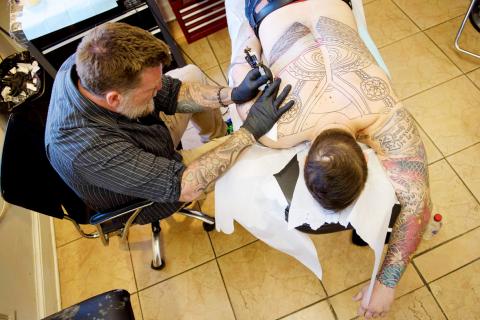An indelible blue drawing of an ornate birdcage, festooned with roses and petals, wraps its way around US Navy Corpsman Jessica Bryant’s forearm.
The 23-year-old sailor’s tattoo is large, but not big enough to be considered a “sleeve,” the type of design that covers an entire arm. Bryant hopes to remedy that, thanks to new US Navy rules in place from yesterday — aimed at attracting recruits among young millennials who have adopted tattoos en masse.
“When they make this really, really legal, I am going to finish the rest of it,” she said during a visit to the Champion Tattoo Co in southeast Washington, across the road from a marine barracks.

Photo: AFP
Until now, sleeve tattoos have been barred under US military regulations. The navy is scrapping the ban — and going further still — to adopt the most lenient rules on body art of any US military service. From next month, sailors will also be allowed a tattoo on their neck — up to an inch across — and restrictions will be lifted on ink below the knee or elbow, including on the hands. Additionally, sailors with visible tattoos will be allowed to work as navy recruiters, a gig that was off-limits to them before.
“Everyone’s really thrilled,” said US Navy Corpsman Everette Abney, 28, as he perused tattoo designs to add to the colorful selection already on his forearm.
News of the rule change was up on “Facebook for maybe an hour, and it had been shared about 40,000 times,” Abney said.
His friend, US Navy Corpsman Taylor Hoyte, 20, is getting a tattoo of a pair of interlocking hands as part of a design that will eventually be a sleeve.
“I want to keep going until I run out of room, from the neck down,” Hoyte said.
Tattoos are a longstanding tradition among sailors the world over — think Popeye and his anchor — reaching back to the 18th century.
However, in recent decades, as the military sought for troops to project a more uniform and professional image, even the navy restricted what kind of tattoo sailors can wear.
With the practice more popular than ever among millennials and hipsters, the navy’s latest easing of the policy is aimed at reaching a wider array of potential sailors. According to a Harris poll, 47 percent of Americans born in the 1980s and 1990s have at least one tattoo.
“This policy has increased the pool of candidates we recruit from. Will we get new recruits that wouldn’t have previously applied to the navy? I think absolutely, yes,” US Navy spokesman Lieutenant Commander Nate Christensen said in a telephone interview.
“The navy strives to reflect the nation we serve, to attract, recruit and retain the nation’s best talent,” Christensen said.
Offensive, overly vulgar or racist tattoos remain off-limits.
Military tattoo restrictions have long stoked ire among rank-and-file troops. Many grumble that if they can die for their country, they should be able to express themselves on their skin.
“Today’s military needs to understand ... that letting service members have tattoos with less restrictions adds to their own esprit de corps. It boosts morale. It allows them to tap into an ancient warrior spirit,” said Butch Johnson, owner of the popular Washington tattoo parlor, which is next to a hip eatery.
“It is the one personal item that can be taken into a battlefield and give a service member that extra edge, a feeling of power, a reminder of family, patriotism, pride — and a tattoo can’t be taken away,” Johnson said.
Johnson said US Marine Corps restrictions on tattoo sleeves — when they were implemented locally in 2012 — had hurt his bottom line.
The bearded artist traced his buzzing tattoo gun over the skin of Tyler McManus, 24, a former Marine who said he was not allowed to re-enlist in part because of his extensive tattoos.
“A lot of people that had tattoos were ‘volun-told’ to get out,” said McManus, who is getting a huge Polynesian tribal design inked across his back.
The popular military phrase: “Si vis pacem, para bellum” — If you want peace, prepare for war — stretches across his chest.
Since leaving the marines in 2014, he has had a full-sleeve depicting a carp and a dragon in Japanese style etched onto his left arm. Now he is considering enlisting with the navy because of the service’s new rules.
“With the lax tattoo policy and the way that I read it, I would be much more obliged to go back into the navy to serve with them,” McManus said.

ANGER: Unrest worsened after a taxi driver was killed by a police vehicle on Thursday, as protesters set alight government buildings across the nation Protests worsened overnight across major cities of Indonesia, far beyond the capital, Jakarta, as demonstrators defied Indonesian President Prabowo Subianto’s call for calm. The most serious unrest was seen in the eastern city of Makassar, while protests also unfolded in Bandung, Surabaya, Solo and Yogyakarta. By yesterday morning, crowds had dispersed in Jakarta. Troops patrolled the streets with tactical vehicles and helped civilians clear trash, although smoke was still rising in various protest sites. Three people died and five were injured in Makassar when protesters set fire to the regional parliament building during a plenary session on Friday evening, according to

‘NEO-NAZIS’: A minister described the rally as ‘spreading hate’ and ‘dividing our communities,’ adding that it had been organized and promoted by far-right groups Thousands of Australians joined anti-immigration rallies across the country yesterday that the center-left government condemned, saying they sought to spread hate and were linked to neo-Nazis. “March for Australia” rallies against immigration were held in Sydney, and other state capitals and regional centers, according to the group’s Web site. “Mass migration has torn at the bonds that held our communities together,” the Web site said. The group posted on X on Saturday that the rallies aimed to do “what the mainstream politicians never have the courage to do: demand an end to mass immigration.” The group also said it was concerned about culture,

Australia has announced an agreement with the tiny Pacific nation Nauru enabling it to send hundreds of immigrants to the barren island. The deal affects more than 220 immigrants in Australia, including some convicted of serious crimes. Australian Minister of Home Affairs Tony Burke signed the memorandum of understanding on a visit to Nauru, the government said in a statement on Friday. “It contains undertakings for the proper treatment and long-term residence of people who have no legal right to stay in Australia, to be received in Nauru,” it said. “Australia will provide funding to underpin this arrangement and support Nauru’s long-term economic

Philippine President Ferdinand Marcos Jr has fired his national police chief, who gained attention for leading the separate arrests of former Philippine president Rodrigo Duterte on orders of the International Criminal Court and televangelist Apollo Carreon Quiboloy, who is on the FBI’s most-wanted list for alleged child sex trafficking. Philippine Executive Secretary Lucas Bersamin did not cite a reason for the removal of General Nicolas Torre as head of the 232,000-member national police force, a position he was appointed to by Marcos in May and which he would have held until 2027. He was replaced by another senior police general, Jose